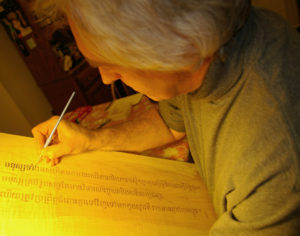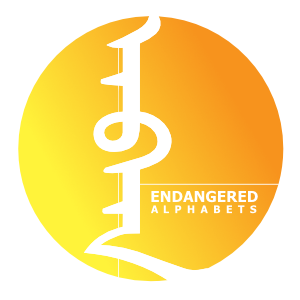 When I began carving in late 2008 I wasn’t a linguist, or an anthropologist, an artist, or even a woodworker – I was a writer. But for Christmas I decided to carve everyone in my family signs to hang outside the front door, in the office, even outside my teenage daughter’s bedroom door.
When I began carving in late 2008 I wasn’t a linguist, or an anthropologist, an artist, or even a woodworker – I was a writer. But for Christmas I decided to carve everyone in my family signs to hang outside the front door, in the office, even outside my teenage daughter’s bedroom door.
Christmas arrived, and everyone seemed to like their gifts a lot. The combination of the wood I was using (beautiful Vermont quilted maple, with the bark still on) and the act of hand-carving, seemed to elevate what I was doing from mere signage to something approaching, well, art. Moreover, I enjoyed carving so much I came up with Chinese monograms for everyone in the family and carved them into a flute case, a set of wooden plates, planters.
Something else was happening: I was starting to see that there was a curious advantage to unfamiliar scripts. If you stare at a letter or word and have no idea even how to sound it out, you start looking at that letter not as an atom of sound or of meaning, but as a design. It becomes, in a strange way, a hand-made work of art, something that someone has shaped with a pen or a brush or a stylus or even a knife. Subtract meaning and you get art. Nobody really cared whether their carved monograms meant what I said they meant – they loved the fact that they were fascinating and unusual and fluid and graceful.
Looking for other characters to carve, I came across the website that changed my life: Omniglot.com, a site dedicated to all the world’s writing systems, past and present, extinct and living, real and imaginary.
I was stunned, first of all, by how many of them I’d never heard of. As a travel writer, I’ve seen a fair amount of the world, but at least three-quarters of this panorama of alphabets was new to me. And what a panorama! What an array of inventions! What staggering variety! Some characters seemed more like elaborate decorations than meaningful symbols; some looked more like thickets of thorn bushes; some seemed utterly alien, as if the hand of man had had nothing to do with their creation at all.
As I went through the site’s A-Z, I was struck by something else. A substantial minority of these scripts were already extinct; many others had fallen into disuse, supplanted by more universal scripts such as Arabic, Chinese, Cyrillic, or the Latin alphabet we use in the U.S. and Europe. Even though the world has more than 6,000 languages (some of which will be extinct even by the time this article goes to press), it has only about 300 scripts, and perhaps 90% of those are endangered–-no longer taught in schools, no longer used for commerce or government, understood only by a few elders, restricted to a few monasteries or used only in ceremonial documents, magic spells, or secret love letters.
The text that Simon Ager, the creator and curator of Omniglot, had chosen to illustrate most of these writing systems came from the Universal Declaration of Human Rights (UDHR), adopted by the United Nations in 1948:
All human beings are born free and equal in dignity and rights.
They are endowed with reason and conscience
and should act towards one another in a spirit of brotherhood.
This exhortation, in combination with the rarity or even extinction of so many of the languages and/or writing systems of the world, seemed bitterly ironic: the endangered alphabets had shrunk to the margins of their societies precisely because people had not acted towards each other in a spirit of brotherhood. A more powerful nation had overwhelmed weaker ones; majorities had suppressed minorities; and now the global expansion of computing and the Internet had accelerated the process of extinction. These gnarly or magnificent old scripts were being replaced by the beige, rectangular uniformity of the keyboard.
I decided there and then that I’d carve Article One of the UDHR in maybe eight or ten of the most endangered writing systems. The first exhibition of the Article One carvings was held in May 2010, and to my astonishment people began talking about it, writing about it, even filming it. Within nine months it had been exhibited at several colleges, universities, galleries and libraries, it had become the subject of a video documentary, and had been written up in the New York Times.
Over the next couple of years my interest in the Alphabets expanded. Instead of working with the initial 13 scripts, I sent out pleading emails all over the world and managed to find people who could still furnish me with text in 20 endangered writing systems. And instead of staying with the Universal Declaration of Human Rights I decided to write my own poem as a kind of Alphabets anthem:
These are our words, shaped
By our hands, our tools,
Our history. Lose them
And we lose ourselves.
By a remarkable chance, this poem project led to a new, activist direction for the Alphabets. I met a man named Maung Nyeu, who was from the Chittagong Hill Tracts (CHT) in Bangladesh. He had stumbled on my website and seen, to his amazement, that someone not only knew about the languages of the Hill Tracts but had actually carved them.
The Hill Tracts, a forested upland area in the southeast of the country, are home to a dozen indigenous peoples, distinct from the majority Bengali population in language, culture, and religion. Over the past two decades, the region has become increasingly militarized, more and more the area’s traditional farmlands have been given to Bengali settlers, and indigenous children have been schooled only in the national language of Bangla, which most of them don’t speak even as a second language. This profound disadvantage has essentially cut the children off from education: more than half of all household members have no formal schooling, and for those who start school, fewer than eight percent complete primary education while only two percent complete secondary education. In other words, there is a dropout rate of 98%.
These deficits have devastating long-term effects. Experience in the U.S., Canada, Australia, and elsewhere shows that if indigenous children are educated in a language other than their own, their success rates are low, and dropout rates high. As they grow older, those same grim statistics convert into rates of unemployment, violence, and suicide. In a single generation, Maung said, he has seen his people go from being self-sufficient farmers, living on ancestral lands, to being vagrant day-laborers.
Remarkably, Maung survived his dysfunctional schooling. His mother home-schooled him with such success that he went on to the University of Hawaii to earn a degree in engineering, then an MBA from the University of Southern California. Equipped with those skills, he returned to the Hill Tracts to build the Padamu Residential Education Center, a school on the grounds of a Buddhist temple, so the children of the Hill Tracts could be educated in their own languages.
As one aspect of this mother-tongue education, he was in the process of collecting stories passed down in the villages of the Hill Tracts. He was starting the long process of recording those stories, getting them illustrated in a visual idiom familiar to the children, having them translated into Mro, Marma and Chakma.
To do so, though, Maung faced an additional challenge. The spoken languages of the Hill Tracts are under threat, but the written languages—the writing systems or scripts—are in even greater danger. Most of the Marma, as well as groups such as the Mro and Chakma, still speak their traditional languages, but very few can still read and write their unique scripts. That’s where the Endangered Alphabets came in.
In June 2012, Maung and I set up a partnership to create and publish his schoolbooks and to help save the languages and support the people of the Chittagong Hill Tracts. This project profoundly changed the Endangered Alphabets Project: ever since then, instead of drawing people’s attention to linguistic disappearance and cultural erosion, I’m now trying to do something about it.
In partnership with an increasing range of people all over the world who want to preserve or revive their own traditional language and culture, we’re creating children’s books in indigenous languages and scripts.
We’ve published coloring books and games to help teach children their (endangered) letters.
We’re going into classrooms in schools and colleges in the United States so our own children will understand the vital importance of cultural diversity.
We’ve created the first endangered-alphabet board game and word search puzzles, and the world’s first digital interactive atlas of endangered writing systems.
In short, we do whatever we can to support the efforts of indigenous and minority peoples everywhere to regain the identity and respect they are in danger of losing permanently.
Will you help us?
Tim Brookes
Burlington, Vermont
